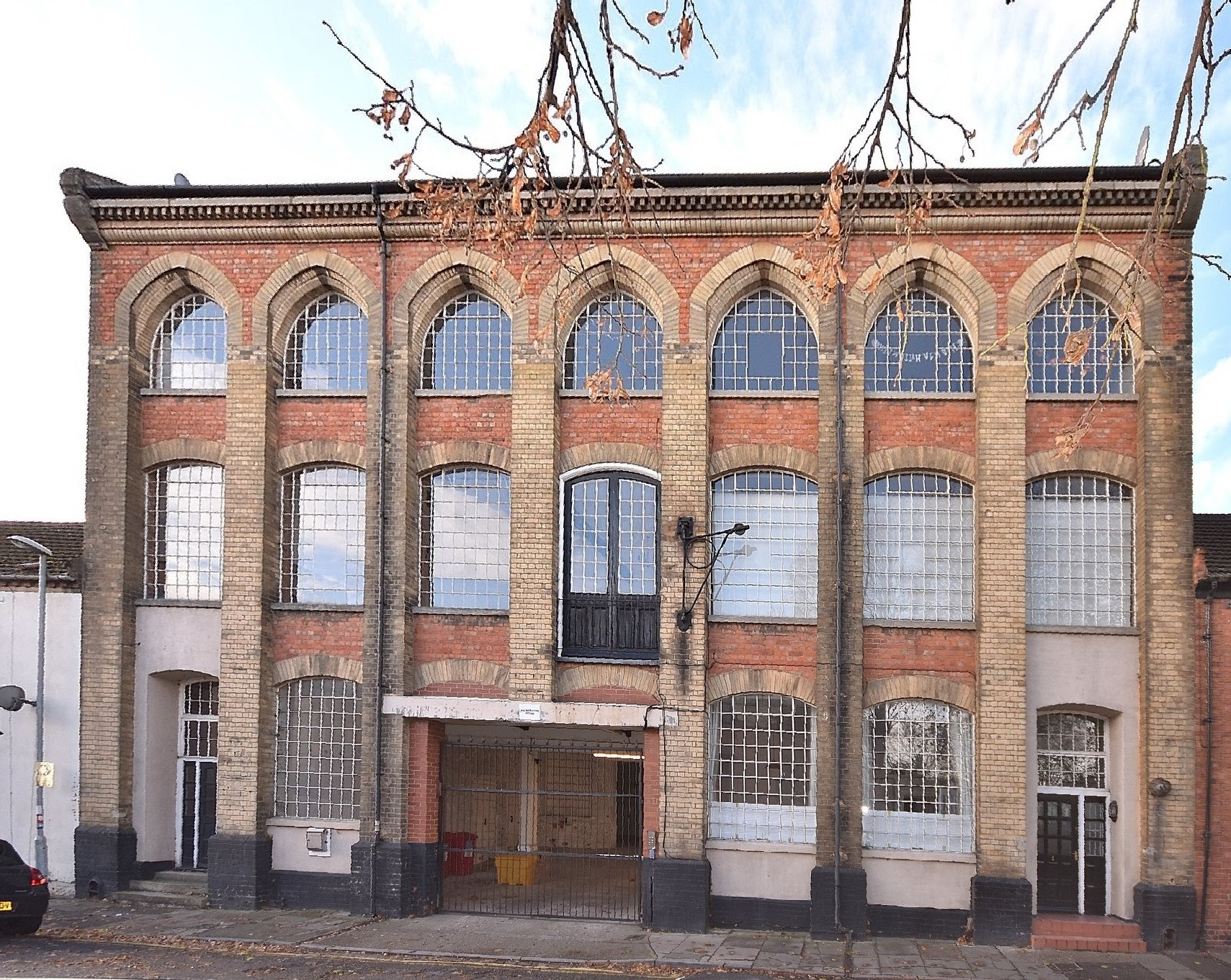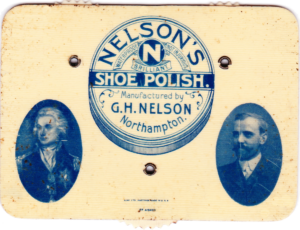George W H Nelson was born in Northampton in 1863. At the time of his birth, his parents George Nelson and Mercy (née Major) were living at 11 Lower Grafton Street, Northampton.
His parents: George and Mercy Nelson
George and Mercy Major were married in 1860 at their parish church, Holy Sepulchre. At the time of marriage, he described himself as a shoemaker, but a year later in the 1861 census, he was recorded as a bookseller. It is probable that George and Mercy only rented a room at Lower Grafton Street as the property was the main residence of James Ridley and his family who also had a lodger.
Between 1863 and 1871 George and Mercy had four more children after George W H., two sons and two daughters, and a further two, a son and daughter in the 1870s.
George had a series of engagements in a variety of occupations during his early working life. His first job was with a bootmaker, William Hollis in Silver Street. After some years he left to work at a timber merchant in Abington Street, Mt Whitmee. By 1871 the family had moved to Leiston in Suffolk, where George (senior) was a ‘Grocer and Draper’. This was a common ‘sells everything’ type of store that supported independent village life in the 19th century.
By 1873 the Nelson family had moved back to Northampton where George had taken up employment at Manfield’s shoe factory. At Manfields he was responsible for timekeeping a role he held for over 50 years through to the 1920s. George and Mercy lived at the West Lodge of the factory, 367 Wellingborough Road and continued to live there into retirement. Mercy died in 1928 and George in 1930. They were buried at the General Cemetery (Billing Road). The gravestone was later removed but read:
In Loving Memory of MERCY, the beloved wife of GEORGE NELSON, who passed away on August 10th 1928. Aged 89 years. Also of GEORGE, the beloved husband of Mercy Nelson, who passed On September 22, 1930, Aged 91.
A short notice of George’s death in the Northampton Chronicle and Echo records that he was a prominent Liberal and very interested in the Co-operative movement.
The death occurred on Monday of Mr. George Nelson, of 11, Holly Road, Northampton, at the age of 91. Mr. Nelson was employed at Messrs. Manfield from 1873 until a few years ago, when he retired on pension. He was one of the pioneer workers of the Liberal cause many years ago, and was very interested in the Co-operative Movement. Mrs. Nelson died two years ago at the age of 91, shortly after celebrating her diamond wedding. Two sons and three daughters are left to mourn their loss. One son is Mr. G. H. Nelson, the polish manufacturer, of Palmerston Road, Northampton. The interment will take place in the General Cemetery on Thursday morning.1

George William Horatio Nelson

After the family’s return to Northampton, we find George, now aged 17, in the 1881 census living with his parents in Shakespeare Road, Northampton. He was now working as a Printer.
George married Julia Copson at his parish church, St Lawrence, Northampton in 1889. Their first of four sons arrived in 1891 and by the time of the census the same year, the family was living at 12 Holly Road, outside the parish of St Lawrence. George had now become a white collar worker describing himself as a Boot Trade Bookkeeper. In 1893 and 1895 two more sons George and Harold were added to the family. In 1901 they were still at Holly Road but had moved across the road to no. 11. This was a slightly larger property and may have also been a move from renting to owning their own house. George was now described as a Boot and Shoe Buyer heading up the Boot Buying Department for Manfield & Sons. In 1902 their last son Douglas arrived.

In business, 1901-1950
In 1901 he set himself up in business from premises in Victoria Street as a High-class Boot Dressing manufacturer, by taking over the business of Master & Sadler. In 1902 he took over the business of Earle & Co. and in 1903 moved to another property in Clarke Road. From this time he appears regularly in the trade directories as a Boot Polish manufacturer. The Clarke Road building (now demolished) was on the west side of the road between Brook Manufacturing’s clothing factory (also demolished) and Abington Avenue. There was a further addition by the acquisition in 1907 of The Boot Polish Co. of Bailiff Street. There was a small fire at the premises in 1908 but the factory was enlarged the same year. The business was steadily growing as in 1913 George relocated his business to larger premises in Palmerston Road opposite St Edmund’s church. This building survives and like many former buildings associated with the boot and shoe industry is now converted to residential use.


Palmerston House is an impressive building at the end of a residential street. It features large metal framed windows to maximise light in the workshops and Gothic arches above the second-storey windows. It was built in the 1870s and initially occupied by E Blakey & Sons, famous for their metal heel tips “Blakey’s Segs”.
In later years George’s son, Ernest Horatio Nelson took on responsibility for manufacturing. George died on 25 March 1952, aged 88. His wife, Julia, died in 1955.
Palmerston House
The Palmerston House building played a significant role in the lives of the Jewish community in Northampton during World War 2. The Jews and their Hebrew congregation had had a presence in Northampton since the 19th century and many Jewish industrialists and other refugees moved to the town from Europe. Their numbers were swelled by an influx of Jewish servicemen. They were made welcome in the town and various facilities were provided for their use including a Jewish Youth Centre in South Street organised by a refugee, Mr Bach; a soldier’s canteen in St Michael’s Road; a Jewish Forces Centre in The Riding and a Kosher canteen in Palmerston House. Much of this activity was coordinated by the Northampton Jewish Ladies Guild.2 3
The business appears to have been put up for sale in 1951 as the following advertisement appeared in the Northampton Mercury4:

Marketing and publicity
An item in my possession originally drew my attention to the business of G H Nelson. It is a small celluloid advertising card in the format of a device for recording scores and ‘trumps’ during a game of Bridge or Whist.


The front depicts a tin of Nelson Polish with their ‘N’ logo, Admiral Horatio Nelson and George Horatio Nelson. On the reverse are revolving counters for card games. The front of the card also indicates the cards were supplied by Ajax Ltd of Hastings, a printer, but manufactured in the United States. The item is identical to other merchandise manufactured by Whitehead & Hoag of Newark, New Jersey.
It is likely that George’s time as a printer helped to develop his eye words and imagery in promoting his business as seen in the following examples.



- Northampton Chronicle and Echo, 23 September 1930
- Jolles, Michael. “The Presence of Jews in Northampton.” Northamptonshire Past & Present, vol. 57, 2004, pp. 54–68, https://www.northamptonshirerecordsociety.org.uk/pdf/npp/number/npp-n57.pdf
- Between 1888 and 1912 Palmerston House had been the shoe manufacturing premises of A & W Flatau & Co., from a London-based Jewish family. Credit: Marcus Roberts, Director of JTrails, http://www.jtrails.org.uk/trails/northampton/history?page=8 The Flatau business operated from various premises in Northampton: Market Street from 1878, then Victoria Street until 1888 when then moved to Palmerston Road where they remained until moving back to London by 1912.
- Northampton Mercury – Friday 31 August 1951, p10
© Copyright : Graham Ward. All rights reserved.